E.L. Parfitt's Blog
January 31, 2024
A Gypsy's Curse
https://www.amazon.com/dp/B0CTKQDSTZ?...
It's been a busy year. I won two prizes for an extract of this novel.
What it's about in a sentence: a Gypsy storyteller marries a fisherman and meets a genie.
The fuller blurb:
In a windswept Scottish village in 1815, a Romani storyteller faces a deadly curse and a hostile community. Can she save herself and her love from a genie’s wrath and the villagers’ hate?
Mairead has always longed for a home and a family. But when she marries Lachlan, a Scottish fisherman, she is met with suspicion and scorn by the people of Auchenmeall, who despise her Gypsy heritage and her stories. Her life becomes even more perilous when her husband pulls a bottle from the sea that contains a genie, who gives Mairead a year to choose her own death. As the genie’s curse looms over her, Mairead must also deal with accusations of witchcraft, betrayal, and murder, as well as the secrets and lies that threaten to tear her family apart.
A Gypsy’s Curse is a historical fiction novel with a twist of fairy tale and fantasy. It is inspired by the Scottish folktale The Fisherman and the Genie, and explores the themes of identity, prejudice, and destiny. If you enjoy stories of magic, romance, and mystery, you will love this book.
https://www.amazon.com/dp/B0CTKQDSTZ?...
E
August 24, 2021
How a sentence can tell a story
I was stopped in my tracks today by this humble sentence about a character’s eyes from Jodi Picoult’s The Book of Two Ways:
“They made me think of the heart of a glacier, of how, even when you touch dry ice with your bare skin, you cannot let go even if you try.” (p.18)
She’d already won me over at this stage with her depictions of Egyptian hieroglyphs and history and references to IndianaJones. What I love about this sentence is the sensory and emotional experience. I’m sick of reading she/he had green or grey eyes when the majority of people have brown, followed by blue (in certain cultural contexts). So blue eyes, check, while avoiding the cliche’s of a lake, the sky, etc. Double check! We instead get treated to ice reflecting the sky in its centre in a form of a glacier, making me feel the character's cold disinterest in me. Then she choses the word ‘dry’ reinforcing this lack of life, and yet ‘with your bare skin’ brings to mind the sensual. Exactly. The women is describing an ex-lover. Thus, being stuck to the ice (‘you cannot let go’) is more about tongue and lolly freeze, we are transported to a place of shivery recognition of the attraction she is describing. It wasn't a mistake Picoult used 'heart' after all. She does not want to become unstuck from this man. As a reader, I assume at this point as I haven't read further, the story will bring them into contact once more. No spoilers here. Combined, physical, emotional and narrative connections work together in one simple sentence. Doesn’t feel so simple after all now, does it?
Okay, excuse me, I have to go and read some more ...
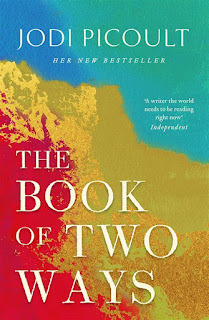
May 14, 2021
Elephant Tusks

Inspired from the above photograph Rainbow by Helen Patience from the Hold Still digital exhibition, I wrote the following poem.
The Duchess of Cambridge and the National Portrait Gallery revealed the winners in 2020, which featured 100 portraits from 31,598 submissions during the project’s six-week entry period. The images aimed to record of our shared and individual experiences during lockdown, and have been exbitited in Times Square in London.
Elephant tusks
Grey, What of grey?
A rainbow window. A little girl.
Upturning the gravel of her mind.
A lassie’s sunflowered Macintosh waves from a distance
bending towards her ma’s swan neck cocooned in a tartan scarf.
Amber, turquiose and carmene are easy to understand, but what about grey?
A woven net of grey weaves infront of her eyes, danglng on a stick.
Pencil on paper the girl composes a list:
scaffolding,
TV aerials,
paperclips,
guitar strings,
tins of peaches,
hubs on the car,
water pipes,
elephant tusks.
Ma’s youthful face and silver hairs.
Da’s lead eyes crinkling at the edges.
Seals’ graceful stares.
To say your world is grey, she decides, makes it full of unpredictable things ...
like in stories, where silver fills chests guarded by saucer-eyed dogs.
It glints off wolves’ pelts amongst birch bark.
Pays the boatman across the River Styx.
Yet it is not as sought after as gold or ivory.
Could be, like an elephant tusk, the colour of our soul is beautifully ashen.
Example: the shadowy line between stealing a pound from Ma’s purse or not.
Grey, then, is even the hue of consciousness.
A rainbow window. A little girl.
Upturning the gravel of her mind, to seek coined fishes.
March 9, 2021
Research, research, research!
Based on the initial research I have done into the lives of gypsies in the UK and fisherfolk in Auchmithie, to get a sense of their lives and challenges, I have begun to draft my early scenes in my new noval (The Fisherwomen of Auchmithie). I can’t wait till the museums reopen to visit the local area and the Lighthouse Museum again. Thanks to the website Auchmithie Roots, and their historians, I found mention of Auchmithie in The Country of Scott. Including the following description of the inside of one of the fisherman’s cottages.
He let me take a photograph of the interior of the cottage, where a single room served for bedroom, breakfast-room, kitchen, and numerous other purposes. (p.157)
So not adding much information to what I had already guessed or discovered, though I'd love to chat to an expert in working-class women's lives in the early 1800s. The text also mentions policemen referred to as constables and ‘a picturesque old fishwife’:
A picturesque old fishwife, carrying two large empty pails in each hand, came out of her house, all unconscious of the awful presence of a loaded camera and I quickly stepped out and pressed the bulb. ‘That’s Coffee Betz you got then,’ laughed the constable. ‘She wouldn’t let you take her picture, but she’s one of the Cargills.’
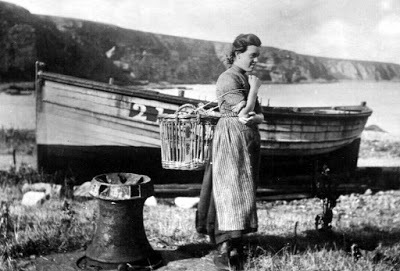
Fisherwife in Auchmithie
And there is some useful historical context of the French-British conflicts in the early 19th century (1800s) relevant for life in Auchmithie:-
the people of England and Scotland were kept in a state of nervous dread by the expectation of an invasion by the French. Beacons were erected all along the coast ready to give instant alarm, and militia organizations were everywhere kept in a state of readiness. (p.158).
Relevant for a fishy context too; though perhaps only interesting to me ... For instance, there’s a mention of bannock-fluke and cock-paddle in the book, which some additional research revealed are turbot (Scophthalmus maximus) and lumpfish (Cyclopterus lumpus) which is great to know as my main characters include fishermen and women.
There is plenty more writing and research to go. So for now, I'll concentrate on the writing side, building my characters and making notes on the side about facts to check. These are but little details to weave into the narrative as I try to capture the lives of the people living back then on the east coast of Scotland.
March 4, 2021
The Antiquary
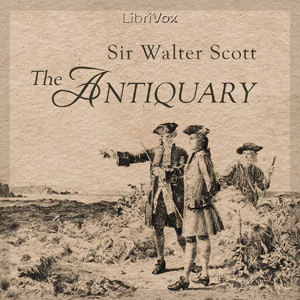
On conducting research for my current book The Fisherwomen of Auchmithie, it’s been tough going finding information on the lives of fisherfolk in the 19th century. I began to read The Antiquary(Walter Scott), as cited on some websites. However there is but one description of the inside of a fisherman’s cottage. So from his descriptions I have learnt about the humble Scottish fisherman’s cottage that
· * there is a fireplace/hearth inside (possibly coal lit, but this was from other description in another class of housing so might be incorrect) which is for heat, light and cooking
· * wooden trenchers are used to prepare food
· * which is fried, broiled and smoked fish, plus bannocks [Scottish cake made from oatmeal] and car-cakes [crumpets]
· * mugs of beer [other sources mention ale]
· * grandmother is found by the fire in a chair spinning wool (spindle and distaff method)
· * the door of the cottage closes with a latch
Yet here is some nice commentary on the importance of the fisherwives taking care of the home when the men were fishing up and down the coast which I had read via other sources.
fisher-wives ken better – they keep the man and keep the house, and keep the siller [silver] too
As soon as the boat touches the sand, the fishermen work, but the wives take the fish ashore, carry the fish in creeils to the next town and sell them.
As sune as the keel o’ the coble touches the sand, deil a bit mair will the lazy fisher loons work, but the wives maun kilt their coats, and wade into the surf to tak the fish ashore. And then the man casts aff the wat [wet] and puts on the dry, and sits down wi’ his pipe and his gill-stoup ahint the ingle, like any auld houdie, [...] the wife, she maun get the scull [creel] on her back, and awa wi’ the fish to the next burrows-town, and scauld and ban wi’ther till it’s sauld [sold]
I have provided some translations for those unfamiliar with the Scots language. I hope this brief post is helpful.
How to find an agent ...

I felt inspired by this quote today from K.Welsh:
"When I was querying agents with The Wages of Sin, I posted the opening chapters to my website on the off-chance someone might see it, and Laura Macdougall, who was then commissioning editor at Hodder & Stoughton, fell for my cunning ploy and emailed me asking if she could read the whole thing. She was planning on switching to being a literary agent and, once she’d sent me back a hand-edited first draft with a box of chocolates, I knew I’d found the perfect agent!"
Well, why not, I've been showing my first pages to beta-readers over the past few weeks to get feedback and thought I would share the same opening scene here too. I had more rewriting to do than planned because of my current book A Friendship of Thistles being set during the time period 2019 to 2020. If you've read any of my other posts you already know that then lockdown happened and I began to rewrite the book.
So here it is ... scene one.
October 2020
A brass bell chimed as an unexpected visitor pulled its cord. Its resonant clang reminded Heather of Maither’s cowbell; a souvenir brought back from Austria from their only holiday abroad. Irvin had brought the bell back from Tibet in an October as grey as this one – dreary tarmac and sky, an airborne peppering of drizzle – he had joked that it would cleanse people’s souls, releasing their suffering, before they could enter hishouse: her house now. She hoped, in death, that her friend had found his ‘singing sun’.
‘Hector!’ Heather flung her arms open – the Scottish-wide ban on household visits be damned. Small flecks of rain speckled his glasses and raincoat, though not enough to dampen her dress. ‘Where’s Fran?’
Hector’s shoulders stiffened.
She led him into the kitchen, their staggered footsteps echoing on the sandstone tiles like her heartbeat; the late-blooming hydrangeas, exploding outside the wall of windows, matched the pigmentation in her cheeks. ‘Want a cuppa?’
‘If there’s Earl Grey.’
She poured her cold jasmine tea down the sink, eyes on his back as he inspected the garden, face pale – even for a Scotsman – against the contrast of his ginger tufts.
As they waited for the boiling kettle she fiddled with the end of her chestnut-grey ponytail and asked herself: what’s wrong here? Hector held himself differently. Usually, he posed a risk to breakable objects or, and on more than one occasion, he’d poked someone in the eye. Yet his arms rested today by his expanded waistline.
He spoke over the bubbling of the kettle, ‘The kids have missed you for Sunday lunches.’
The mugs in her hands knocked the granite countertop as she jerked. What more to say: other than she agreed. She could’ve reached out. If she hadn’t … if Fran hadn’t … They’d both been hurt. An inadequate word for the rupture of a friendship.
‘You didn’t visit or pick up the phone.’ He moved, unsteadily, to a kitchen stool.
She waited for him to say Fran was ill, dying, dead. What could it be? She pictured tall, delicate-boned Fran with her choppy bob.
He tapped his teaspoon against his wrist; a soothing drumming pace, if she read him right.
The rain had given way to an autumn mist that insulated the house from the sun and emphasised the tick-tock of her feet on the tiles, from the kitchen island to the cupboard that held the tea, and the tac-tac of grandfather’s pendulum in the dining room.
‘There’s a mathematical formula for rain,’ he said. ‘Well, not rain per se, but rainfall. Intensity, duration, frequency. It’s about droplet concentration and—Sorry, I’m boring you.’
‘Surprising me.’
He blinked, and stared outside as though it was the first time he’d ever seen yellow-leaved birch. ‘Still got their gold.’
Had Fran sent him? Her husband was the peace pipe that could always draw them together. ‘Did Fran—?’
‘Could’ve called,’ he said.
‘Is that what you want me to say?’
He laughed: a broken blast punctuated with missed notes. ‘Except you … you couldn’t … have called … because … because … our phone line … is dead,’ he said, followed by more canned chokes.
How had he and Fran been these past months? More than months. At least a year since the rupture.
He scratched the end of his nose. ‘Me and you and Fran.’
Yes, she remembered. United over roast dinner, Fran often joked.
The primary’s canteen had been an organised war zone where adults unknowingly strode across enemy lines; the boundaries marked by plastic trays, jugs of water, and blocks of tables. The early level tables sat together: chubby hands and milk cartons on plastic chairs. Heather and Hector perched next to the older kids on wooden chairs, swinging their feet off the ground. Most eight to nine-year-olds in their own class were too immature.
Amongst the wooden tables Heather spotted lanky, cropped-haired Fran, with the look of fashion model Twiggy, face-to-face with Alex – new boy and self-imposed know-it-all.
‘Take that back, Alex Simons!’
‘Or what?’
Kids at the nearest tables stopped shovelling beef, tatties and mushy peas into their mouths. Fran shuffled her shoes long enough for Alex’s worm-like lips to wriggle into a smirk and retort, ‘Just ’cause your mom is a dinner lady don’t mean we eat this slop at home.’
Fran’s knuckles whitened on her plastic tray. Heather imagined tatties, peas and an overcooked slice of beef sliding down Alex’s sweater. Fran would get into trouble and her parents would have to pay for damage to his jeans and jumper.
Heather stepped between them. ‘Alex, that was mean.’
‘What if it is? You can’t do anything.’
‘We don’t treat folk that way at this school.’
Confronted with his bored gaze, Heather had no notion what to do if he objected to the rules. But she kenned some of the teachers well enough to know what they would say.
‘Do you ken the expression wee clipe?’ she asked.
Alex regarded Heather’s brown plaits as if tempted to tug on them for daring to call him a snitch.
Heather narrowed her eyes.
Alex stuck his hands in his pockets and said, ‘Don’t be a tell-tale.’
‘I can. Not to the adults. They’ve their own rules. I’m talking about our rules. I can tell every child at this school not to play with you …’ She gave it time for her words to sink into Alex’s thick skull. True. She was fairly well liked. Others regarded her as the default referee for arguments. She could see the cogs in his brain working that out. Liked by the quiet kids too because she made sure that no one sat out during a game. Fairness and the name Heather went hand in hand.
Alex’s smirk wavered.
‘You’re new here,’ Heather said, ‘so I’m going to give you a break. Welcome to Our Lady’s. Come on, Fran.’
‘Awesome, Heather!’ Hector stretched a palm above his fiery curls for their ritual high five.
Warmth spread across Heather’s neck; relief, she guessed from escaping a tricky situation. She flinched as Fran slammed her tray on the table.
‘That twit annoys me,’ Fran said.
Hector swallowed a mouthful of tatties and gravy. ‘It’s only his first week.’
Heather said, noting Alex squirting strawberry milk at his friend Fraser, ‘I think that boy would annoy astronauts on the moon.’
A half-laugh ruptured Fran’s frown. ‘That’s a strange thingy to say.’
Heather shrugged.
‘Heather’s mum’s a dinner lady too,’ Hector said, nudging back his glasses.
‘Which one?’ Fran asked.
‘Ann.’
‘My ma’s Ruth.’
And, as it turned out, they saw more of each other outside school; their mums struck up a friendship, and the girls struck up a companionship of their own. That’s why Fran often joked that Hector, Heather and Fran were united over roast dinner.
Heather nodded to show Hector that she remembered.
He sipped his tea until she couldn’t stomach not knowing.
‘Why aren’t you with your wife?’ she asked.
August 12, 2020
A Shattered Rose or a Captured Heart?
I’ve been asked by some inquisitive readers why my novella Shattered Roses tells Rose’s fragmented story, and why this old lady’s story is told through the eyes of 16-year-old Megan?

To answer this question requires talking about the writing process. It can be so much fun to explore new ways of writing — essentially to see if they work. I’m happy with the final effect, perhaps you’ve read Shattered Roses and disagree. The story came to me in scenes, skipping about with each blink of my eye. I was writing something, but I didn’t know what. I was channelling some confusing emotions at the time (for private reasons I won't go into) and it was fighting its way out of me. I’d also been thinking about time and whether it was a straight line, a ball of string, or more of a Jeremy Bearimy Timeline (A Good Place reference).
We place structure and meaning on our lives, but who's to say that our daily lives aren’t more fluid and mysterious. From these initial scenes I began to imagine Rose in a nursing home telling her version of Beauty and the Beast. One of my favourite fairy tales as a child, and, incidentally, (my mum being a carer) I also grew up around nursing homes. It’s not a setting I come across much when reading, yet one I know by its smell and by its touch.
So far I only had the middle of my story. Megan became my start as she attends an interview for a Saturday job. At first, Megan featured infrequently. I added her only to frame Rose’s story, to force it into a more munchable narrative. One with hints of Scheherazade, here and there. I soon realised that the book was more about Megan’s story, while it is also an uncovering of Rose’s relationship with “the beast”… I began to focus more on revealing Megan's life to her. The mysteries of her own life she couldn't see. At an age where we struggle to find our place in the world.
I also stuck to a novella format to leave gaps purposefully in the story. Yes, I know, I know, sorry! I did it for you, inquisitive reader, to fill, or ponder over, the information I left out. In this way, the book requires a smidge of work on the reader’s imagination. I mean, since you'll be imaging the whole thing anyway... see what I mean? You can draw your own conclusions about the boundaries between reality and fiction. I know that I would choose to believe in magic every time.
I hope you understand these intentions, for whatever English Crit. Lit. says author intentions aren't dead. It's up to you if you wish to carry a fragment of Megan and Rose’s story into your lives… such is the magic of storytelling.
Oh, yes, storytelling, a theme I’ll return to in the book following A Friendship of Thistles (my current project).
There's much I could say about storytelling outside my book Young people, learning & storytelling, instead, I’ll leave you with an invitation (if I may). To dip your toes into Shattered Roses to explore the tip of the iceberg of numerous retellings of Beauty and the Beast. A story which captures our hearts time and time again.
May 15, 2020
Small Great Things
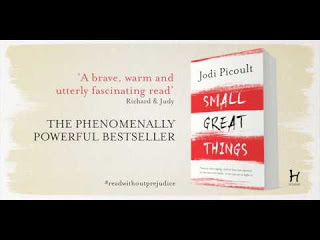
Got excited when I got my hands on this one. However, my first impression was dissapointment. I almost stopped reading when an example of racism given was a lady picking up her purse after catching someone approaching from the corner of her eye. I've done that before, movement in my eye reminding me I should be paying attention to my purse to discover it's my husband. I found it to be the only misplaced example in the whole book. Cause the rest of this book is breathtaking in terms of how the author frames three different stories: Nurse Ruth, a White supremacist and the nurse's lawyer.
I don't want to give anything away. I hope it's enough to say the book is written well and held my attention throughout, once I got beyond the one example mentioned above. It's also an important book for the topics it raises and asks of its readers. Surely a sign of great literature.... but what do you think?
May 5, 2020
Hamnet by Maggie O'Farrell: fleeting & beautful

In describing the theme of the book Waterstones says:
One of our greatest living novelists resurrects the short life of Hamnet Shakespeare, in this lyrically written and emotionally devastating account of the Bard’s only son. Utterly immersive and convincing, Hamnet is a poignant period tale that not only shines a light on an oft-neglected area of Shakespearean history but speaks to wider themes of grief and loss with impeccable poise and unflinching honesty.
The words “speaks to wider themes” I connected to the fact that a single piece of writing can awaken many impressions within us. Reading Hamnet I was reminded of the words of another writer below:
“No single event can awaken within us a stranger whose existence we had never suspected. To live is to be slowly born.”
Antoine de Saint Exupéry (1900-1944).
His point, according to Bodhipaksa, was that these awakenings are not random, they come from somewhere. A chain of cause and effect. I feel that way about writing and reading. It is important to me that each reading/writing experience awakes a recognition of ideas, concepts and feelings within. The associations can be endless such as being “slowly born” above, made me think of burning fires of purification. Perhaps as I have just been reading Hamnet with references to the plague. I love mindful reading: being present in the moment with the story and the sensations and connections the brain makes.
"In living mindfully we are more conscious in the moment of choice. First we become more aware that there are actually choices to be made. Mindfulness creates, or perhaps better reveals, a gap between stimulus and response. In every moment we perceive sensations, thoughts, feelings, and emotions, and we habitually respond to these."Boshipaksa
Why am I referring to mindfulness and philosophy in relation to Hamlet? Because I think the book captures the fleeting impressions of a woman’s growth at different life stages through the characters: Hamlet’s mother, his sister, his grandmother. Grief is a way we grow in maturity through the acknowledgement that life is fleeting and beautiful. These are the words I want to apply to this piece of writing: fleeting, beautiful.
The small accumulative details O’Farrell uses for her character’s day to day lives in a household, their feelings, the journey of a plague across an ocean, are well thought out. For example in this extract:
"...this fit. It is altogether unlike anything she has felt before. It makes her think of a hand drawing on a glove, of a lamb slithering wet from a ewe..."
I was drawn in by Angus. The story of a maturing woman, a sister, a mother, a healer, a caregiver, a griever, an observer.
I won’t say anymore, as you must be the judge. But this is a highly recommended read, like all of Maggie O’Farrell’s books.
April 30, 2020
The hippopotamus by Stephen Fry
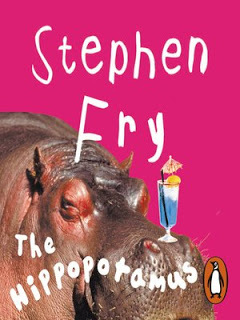 Surprised I managed to finish it, what with juggling work and writing and some time for relaxation and mental health, but this month I read the above novel. And I am struck by the characterisation of The hippopotamus, and thus delved deeper into Stephen Fry’s writing psyche. But not that deepily; at least, not to the depths of a hippo with a cocktail on its nose.
Surprised I managed to finish it, what with juggling work and writing and some time for relaxation and mental health, but this month I read the above novel. And I am struck by the characterisation of The hippopotamus, and thus delved deeper into Stephen Fry’s writing psyche. But not that deepily; at least, not to the depths of a hippo with a cocktail on its nose.The main character of the book is poet and newspaper columnist (and hippo), Ted Wallace. It’s clear from the initial scene that he’s got an inflated sense of self importance as he gets fired and goes to stay with relatives.
I had just been sacked from my paper, some frantic piffle about shouting insults from the stalls at first night.I love these creative descriptions of his editor, that, note, also describe his contempt:
my wet turd of an editor had shrilled
the kind of anile little runt who, in foyers and theatre bars the West End over, can be heard bleating into their gin and tonicsI pause to laugh. Possibly on my own?
Fry's prose is full of such well-chosen details I’m envious. This is the advantage of first-person narrative. However, the book also switches into third person at stages with clever references to random things like sex with horses and yogic meditation that keep me thinking long after I read the last page. Notably, in third person Fry's characterisation shifts to inner dialogue:
The absolute rightness and holiness and perfection and beauty of life charged through him. In this position he could stay for ever, he and the whole kingdom of life
He thought of a circle and within that circle, another circle […] The technique came from a book on yogic mediation he had bought last holidaysLayers of believable details flow on the page due to Fry’s use of sentence construction. After reading his book about poetry construction (The Ode Less Travelled) his writing style doesn't surprise me.
Writing is a lengthy process the reader is usually unaware of: first draft (inspiration), second draft (restructuring and details); third draft (editing errors, inconsistencies, wondering if you can write at all); forth draft (polishing), then often going back to the beginning and starting again.
For my current book (working title: Fran) I’m constructing the details at the moment: those of her life, her children’s and husband’s life and the people she comes into contact with. Then I will be looking into sentence construction in more depth.
I have a book to read on grammar and style that may provide further insights: Grammar as Style by Virginia Tufte. Anyone else read it?



